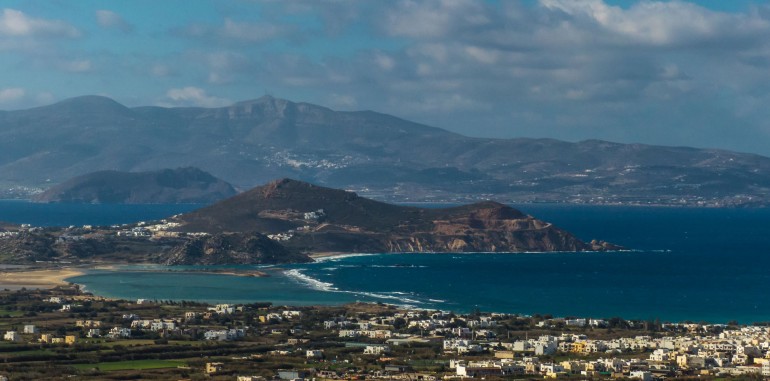Background and Aims
The chert source and associated stone tool knapping floors of Stélida was first discovered in 1981 as part of a single-season survey undertaken by the École Française d’Athènes under the direction of René Treuil, with preliminary publication of the site and chipped stone assemblage undertaken by Michel Séfériadès (1983).
Stélida comprises a 118m high hill located on the extreme west of cape Aghios Prokopios on the north-west coast of Naxos, c. three kilometres to the south of Chora the island’s modern port and capital (Figures 1-2). Today the hill forms part of a promontory into the Aegean, flanked by a narrow strip of flat land to the west, while to the south there is a larger coastal plain and some brackish lagoons, the east being flanked by granite hills, then salt flats and the island’s small airport (Figure 3). Since the 1980’s Stélida has undergone major development, with a series of private residences and hotel complexes that have encroached upon the hill and disturbed the archaeological remains, while to the north the hill has been heavily quarried.
Figure 1: Aerial view of Stélida from the West (D. Depnering).
While Séfériadès discussed the stone tools in some detail in 1983, the date of Stélida’s material ultimately remained unresolved. Arguably the site’s chronology was problematic for two reasons. Firstly, tools of Stélida chert had never been found before in Cycladic excavations, so the material will be dated by association. Indeed, until that point the vast majority of stone tools found on prehistoric sites of the islands (later Neolithic – Bronze Age) were made of obsidian, a black volcanic glass from nearby Melos (Figure 4) Nor did the tools from Stélida look like the implements published from these 5th – 2nd millennium BC sites.
Figure 2: View of Stélida from the East.
Secondly, many Cycladic archaeologists were highly influenced by the work of Cherry (1981), who had argued persuasively that the small islands of the Mediterranean were not occupied until the later Neolithic (5th millennium BC), whereby it would have been contrary to the accepted model of Cycladic colonisation to have suggested an earlier date for Stélida. Today we know that this later Neolithic colonisation model is flawed, with surface finds of alleged Lower/Middle Palaeolithic date reported from Melos, while on Kythnos a Lower Mesolithic site has been excavated and securely dated to the 9th millennium BC millennium BC (Sampson et al 2010).

Figure 3: Aerial view of Stélida showing modern development around the hill and modern airport to the East.
Stélida thus remained something of a chronological enigma after its initial discovery. In 2002 the KA’ Ephoreia of Prehistoric and Classical Antiquities undertook a survey of the western part of the site prior to new building on the promontory (directed by Mrs. Olga Philaniotou), followed by two small-scale rescue excavations in the past decade on the lower eastern and southern slopes of Stélida (directed by Mrs. Irini Legaki). A preliminary report was published on the latter work, which made important claims of finding artefacts of Mesolithic and Upper Palaeolithic date (Legaki 2009).

Figure 4: Islands mentioned in the text.
Our desire to undertake a detailed survey of Stélida’s thus stemmed firstly from its potential to make a significant contribution to our knowledge of the earlier prehistoric Cyclades, in the broader context of other recent discoveries of Palaeolithic activity on the Aegean islands of Crete (Strasser et al 2010), Kephallonia and Zakynthos (Ferentinos et al 2012), and Lesbos (Galanidou et al 2013). Moreover, with the hill having been heavily disturbed by modern construction over the past three decades (Figure 3), we felt a rescue project was desperately needed to characterise and date the hill’s prehistoric exploitation before the evidence is forever lost.
References
Cherry, J. F. (1981), ‘Pattern and process in the earliest colonisation of the Mediterranean islands’, Proceedings of the Prehistoric Society 47: 41-68.
Ferentinos, G., Gkioni, M., Geraga, M. and Papatheodorou, G. (2012), ‘Early seafaring activity in the southern Ionian Islands, Mediterranean Sea’, Journal of Archaeological Science 39: 2167-2176.
Galanidou, N., Cole, J., Illiopoulos, G. and McNabb, J. (2013), ‘East meets West: the Middle Pleistocene site of Rodafnida on Lesvos, Greece’, Antiquity 87(336) (Project Gallery: http://www.antiquity.ac.uk/ projgall/galanidou336/).
Legaki, E. (2009), ‘H archaiologikh ereyna gia thn Pro-Neolithikh, Neolithikh kai Protokykladikh Naxo ws pronomiakos moxlos anaptykshs’, Naxiaka Grammata 1(2): 6-17.
Sampson, A., Kaczanowksa, M. and Kozlowski, J.K. (2010), The Prehistory of the Island of Kythnos (Cyclades, Greece) and the Mesolithic Settlement at Maroulas. The Polish Academy of Arts and Sciences / The University of the Aegean, Kraków.
Séfériadès, M. (1983), ‘Un centre industriel préhistorique dans les Cyclades: Les ateliers de débitage du silex à Stélida (Naxos)’, in G. Rougement (ed.), Les Cyclades: Matériaux Pour une Étude de Géographie Historique, Editions du CNRS, Lyon: 67-73.
Strasser, T., Panagopoulou, E., Runnels, C., Murray, P., Thompson, N. Karkanes, P., McCoy, F. and Wegmann, K. (2010), ‘Stone Age seafaring in the Mediterranean: evidence from the Plakias region for Lower Palaeolithic and Mesolithic habitation of Crete’, Hesperia 79: 145–190.




